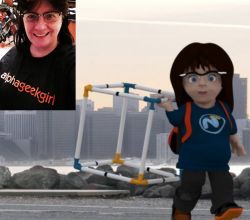Resize the camera icon
If you add an object, sometimes that camera just is a little too big for the scene, especially when getting in close. Or by the same token, if you've got a really large object, your camera is almost invisible; it's too tiny. So under the Display, with that camera selected, there is the Size. This is the view size; it's not the actual size of your renderer or anything else--it's the size of the camera icon.

So you can change that depending on your scene, and what I've often told people is just set it to 0 and it stays relative to your zoom. So notice the camera pretty much stays the same size, whether you zoom in or out, and that's really kind of nice. So I always know where it is. If I zoom out really far, my objects are hard to see, but because I have this size set to 0, I can always find my camera. So, something to think about when you are building larger scenes.












 50%
50%

 [dcs_emptyspace h="10"]Create a new material and set it to a vibrant colour.
[dcs_emptyspace h="10"]Create a new material and set it to a vibrant colour.

